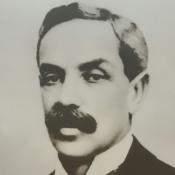Sir Arthur Lowes Dickinson
 Born on August 8, 1859, in London, England. He was a scholar both of Charterhouse School and King's College, Cambridge University, where he was graduated in 1882 with the honor, Wrangler in Mathematical Tripos. He received a master's degree in 1888.
Born on August 8, 1859, in London, England. He was a scholar both of Charterhouse School and King's College, Cambridge University, where he was graduated in 1882 with the honor, Wrangler in Mathematical Tripos. He received a master's degree in 1888.
In 1883, he began his accounting career as an articled clerk with the firm Messrs. Edwards, Jackson, and Browning to obtain the experience necessary to sit for the examinations leading to a CPA. While with the firm he passed the Institute of Chartered Accountants' preliminary examination, intermediate examination (first place honors), and in December, 1886, the final examination (shared first place honors with another candidate). He became a CPA in 1887. He joined the firm of Lovelock and Whiffin as a junior partner in 1888, the same year he was married. He stayed with the firm (Lovelock, Whiffin and Dickinson) until 1901, at which time he assumed senior partner of Price Waterhouse & Co. (then Jones, Caesar & Co.) in the United States. One of his first contributions as an American practitioner was the formulation of a format for the consolidated financial report of United States Steel Corporation, which provided a vehicle for the publicity of complex corporate financial statements. He became an American citizen in 1906 and resided here until 1913, then returned to England with the London office of Price Waterhouse & Co. until his retirement at the end of 1923. He was certified as a CPA in 1903 (Illinois).
He was active in professional activities serving as president (1904-06) of the Federation of Societies of Public Accountants in the United States of America and secretary (1905-06) of the AICPA. He was instrumental in organizing the First International Congress of Accountants in St. Louis in 1904, where he presented the significant paper, "Profits of a Corporation." Upon his return to London he served on the Council of the Institute of Chartered Accountants of England and Wales from 1914 to 1928. Other professional affiliations included membership in Missouri and New York State Societies of CPAs, Institute of Chartered Accountants of British Columbia, Ontario Institute of Chartered Accountants, and Institute of Actuaries.
He returned to England shortly before World War I, serving for two years as a Financial Advisor in the Controlled Establishments Division of the Ministry of Munitions and, subsequently, as Financial Advisor to the Controller of Coal Mines; his services brought him the honor of knighthood in 1919. In 1924 Price Waterhouse & Co. established the Arthur Lowes Dickinson Fund at the Harvard Graduate School of Business Administration. The funds have been used to support accounting research and to provide for the appointment of a Dickinson Lecturer who would deliver one or more lectures during the academic year at the Graduate School of Business Administration.
He wrote many articles for professional journals and presented numerous papers at professional accounting organization meetings. He authored Accounting Practice and Procedure (1913), and edited the Proceedings of the 1904 International Congress. He served as a director of many large corporations and a member of committees of educational institutions During his lifetime he saw the profession of accounting, on both sides of the Atlantic, emerge from the uncertainty of its beginning to prominence.
He was married to Mary Jennings in 1888; they had two children. He died February 28, 1935 at the age of 75.
 Born on August 8, 1859, in London, England. He was a scholar both of Charterhouse School and King's College, Cambridge University, where he was graduated in 1882 with the honor, Wrangler in Mathematical Tripos. He received a master's degree in 1888.
Born on August 8, 1859, in London, England. He was a scholar both of Charterhouse School and King's College, Cambridge University, where he was graduated in 1882 with the honor, Wrangler in Mathematical Tripos. He received a master's degree in 1888.